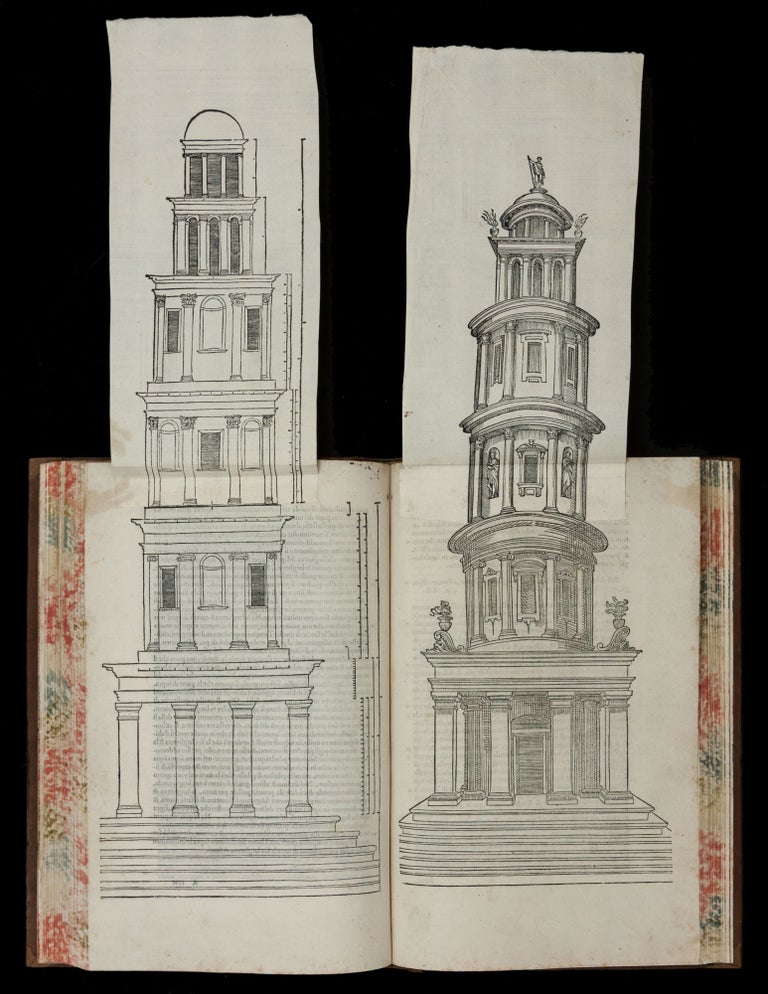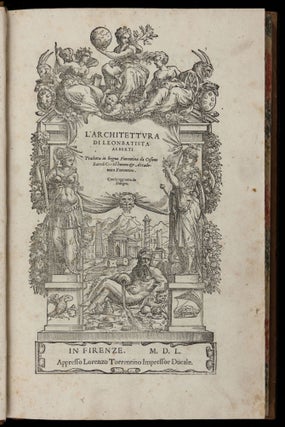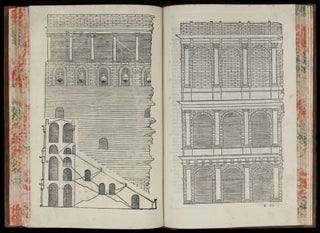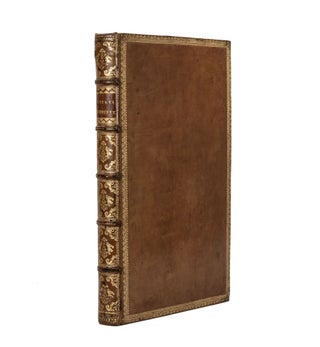L’Architettura di Leon Battista Alberti tradotta in lingua Fiorentina da Cosimo Bartoli ... Con la aggiunta de Disegni.
Folio [32 x 22.25 cm], 404 pp., (11) ff., lacking final blank, with architectural woodcut title, medallion portrait of Alberti on verso of title, 83 woodcuts of diagrams, plans, architectural elevations etc., of which 37 are full page, extensions in upper margins of A4v & A5r as required by Mortimer and mentioned in register at end of book. Bound in 18th-century Roman calf, spine in six compartments showing gilt motifs of a pair of creatures blowing trumpets, gilt morocco title label, covers with gilt borders, gold-tooled board edges, marbled edges, red sprinkled endpapers. Occasional minor marginal spotting and staining, contemporary annotation (concerning Ponte Sant’Angelo in Rome), occasional very minor staining, generally a fresh and crisp copy, with the woodcuts in excellent impressions. Rare first illustrated edition – and fine copy – of Leon Battista Alberti’s (1404-72) L’Architettura (De re aedificatoria), the first modern architectural treatise, here in the influential translation of Cosimo Bartoli (1503-72), who was one of the most important proponents of the use of the vernacular in 16th-century technical publications. This folio work is only the second published version of Alberti’s text in Italian, following (and eclipsing) the 1546 octavo translation of Pietro Lauro: “It was Cosimo Bartoli’s translation of Alberti’s treatise, published with illustrations, that made the text available to a larger group of readers among professional architects. Bartoli’s edition quickly displaced the earlier Italian translation by Pietro Lauro, which was not illustrated” (Millard, p. 21). This 1550 Bartoli edition was thus crucial in widening the audience of Alberti’s original, unillustrated Latin treatise – largely the province of learned humanists – to include joiners, masons, and other architectural practitioners who would shape the built environment of the High Renaissance. The volume’s fine architectural woodcuts were made after designs by Bartoli himself, who likely had the help of his friend and frequent collaborator Giorgio Vasari (1511-74), the massively influential painter and proto art historian. Vasari almost certainly was responsible for the book’s frontispiece and for its portrait of Alberti (S. Gregory, p. 70). Furthermore, “Bartoli’s ideas on architecture probably influenced Vasari’s views, particularly as expressed in the 1550 edition of The Lives” (P. L. Rubin, p. 167). These two highly important vernacular works on art and architecture – Bartoli’s translation of Alberti and Vasari’s Vite – were in fact both printed by Torrentino in the very same year. This 1550 Bartoli translation has today grown scarce on the market, and indeed the work was already very hard to come by within a few years of its publication: In his preface to the 1565 reduced-size (quarto) reprint of the book, Bartoli notes that the 1550 edition, originally printed in 1500 copies, had been “for many years unable to be found in Italy” (f. A2r). “Bartoli’s translations of Alberti’s works are part of his declared interest in the visual arts. In addition to maintaining a working friendship with Vasari – he provided the programs for the decoration of several rooms in the Palazzo Vecchi – Bartoli cultivated close links with several talented artists in Florence and Venice. He was acquainted with Palladio, Tintoretto, Veronese, and Titian, and was particularly close to Giuseppe Salviati, Alessandro Vittoria, and Danese Cattaneo, disciples of the Florentine sculptor Jacopo Sansovino working in Venice. But Bartoli’s translations were meant as much for the educated public as for an artistic readership, and he offered his editions of Alberti to the duke of Tuscany as aids to the study of Vitruvius. His editions of Alberti played an important part in keeping Alberti’s reputation alive” (M. Pollak in Millard, Italian, p. 23). * Mortimer I.12; A. K. Placzek and A. Giral, Avery’s Choice 11; Millard, Italian pp. 21-23; Fowler 6; Wiebenson I-15; J. Bryce, Cosimo Bartoli (1503-72). The career of a Florentine Polymath; H.-W. Krufft, A History of Architectural Theory, p. 49; S. Gregory, Vasari and the Renaissance Print; P. L. Rubin, Giorgio Vasari: Art and History.
Sold




